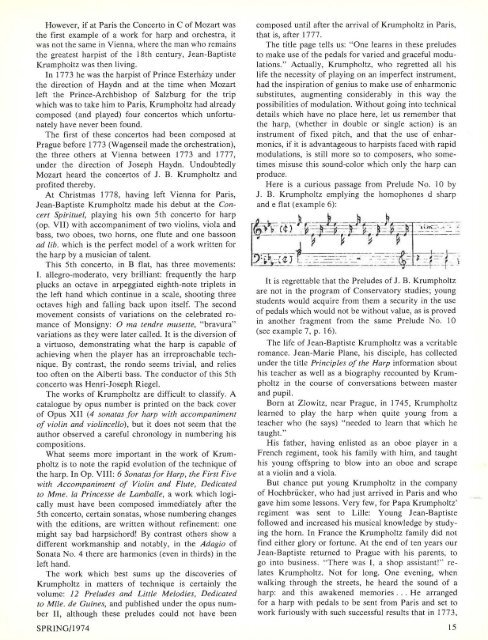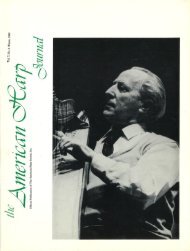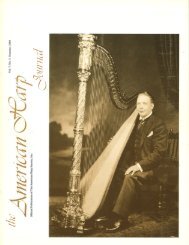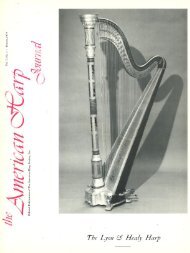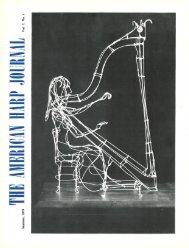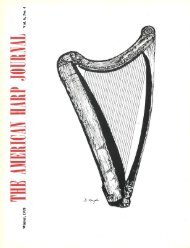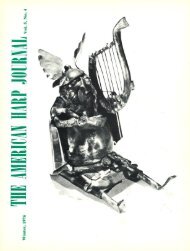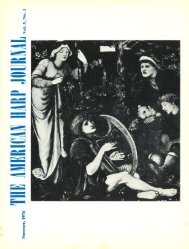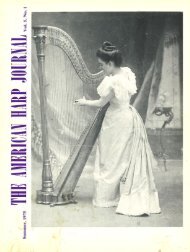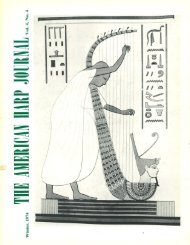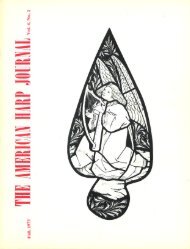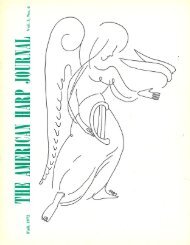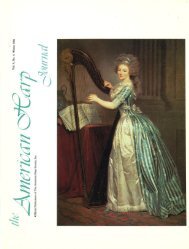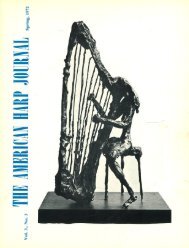Create successful ePaper yourself
Turn your PDF publications into a flip-book with our unique Google optimized e-Paper software.
However, if at Paris the Concerto in C of Mozart was<br />
the first example of a work for harp and orchestra, it<br />
was not the same in Vienna, where the man who remains<br />
the greatest harpist of the 18th century, Jean-Baptiste<br />
Krumpholtz was then living.<br />
In 1773 he was the harpist of Prince Esterhazy under<br />
the direction of Haydn and at the time when Mozart<br />
left the Prince-Archbishop of Salzburg for the trip<br />
which was to take him to Paris, Krumpholtz had already<br />
composed (and played) four concertos which unfortunately<br />
have never been found.<br />
The first of these concertos had been composed at<br />
Prague before 1773 (Wagenseil made the orchestration),<br />
the three others at Vienna between 1773 and 1777,<br />
under the direction of Joseph Haydn. Undoubtedly<br />
Mozart heard the concertos of J. B. Krumpholtz and<br />
profited thereby.<br />
At Christmas 1778, having left Vienna for Paris,<br />
Jean-Baptiste Krumpholtz made his debut at the Concert<br />
Spirituel, playing his own 5th concerto for harp<br />
(op. VII) with accompaniment of two violins, viola and<br />
bass, two oboes, two horns, one flute and one bassoon<br />
ad lib. which is the perfect model of a work written for<br />
the harp by a musician of talent.<br />
This 5th concerto, in B flat, has three movements:<br />
I. allegro-moderato, very brilliant: frequently the harp<br />
plucks an octave in arpeggiated eighth-note triplets in<br />
the left hand which continue in a scale, shooting three<br />
octaves high and falling back upon itself. The second<br />
movement consists of variations on the celebrated romance<br />
of Monsigny: 0 ma tendre musette, "bravura"<br />
variations as they were later called. It is the diversion of<br />
a virtuoso, demonstrating what the harp is capable of<br />
achieving when the player has an irreproachable technique.<br />
By contrast, the rondo seems trivial, and relies<br />
too often on the Alberti bass. The conductor of this 5th<br />
concerto was Henri-Joseph Riegel.<br />
The works of Krumpholtz are difficult to classify. A<br />
catalogue by opus number is printed on the back cover<br />
of Opus XII (4 sonatas for harp with accompaniment<br />
of violin and violincello), but it does not seem that the<br />
author observed a careful chronology in numbering his<br />
compositions.<br />
What seems more important in the work of Krumpholtz<br />
is to note the rapid evolution of the technique of<br />
the harp. In Op. VIII: 6 Sonatas for Harp, the First Five<br />
with Accompaniment of Violin and Flute, Dedicated<br />
to Mme. la Princesse de Lamballe, a work which logically<br />
must have been composed immediately after the<br />
5th concerto, certain sonatas, whose numbering changes<br />
with the editions, are written without refinement: one<br />
might say bad harpsichord! By contrast others show a<br />
different workmanship and notably, in the Adagio of<br />
Sonata <strong>No</strong>. 4 there are harmonics (even in thirds) in the<br />
left hand.<br />
The work which best sums up the discoveries of<br />
Krumpholtz in matters of technique is certainly the<br />
volume: 12 Preludes and Little Melodies, Dedicated<br />
to Mlle. de Guines, and published under the opus number<br />
II, although these preludes could not have been<br />
SPRING/<strong>1974</strong><br />
composed until after the arrival of Krumpholtz in Paris,<br />
that is, after 1777.<br />
The title page tells us: "One learns in these preludes<br />
to make use of the pedals for varied and graceful modulations."<br />
Actually, Krumpholtz, who regretted all his<br />
life the necessity of playing on an imperfect instrument,<br />
had the inspiration of genius to make use of enharmonic<br />
substitutes, augmenting considerably in this way the<br />
possibilities of modulation. Without going into technical<br />
details which have no place here, let us remember that<br />
the harp, (whether in double or single action) is an<br />
instrument of fixed pitch, and that the use of enharmonics,<br />
if it is advantageous to harpists faced with rapid<br />
modulations, is still more so to composers, who sometimes<br />
misuse this sound-color which only the harp can<br />
produce.<br />
Here is a curious passage from Prelude <strong>No</strong>. 1 O by<br />
J. B. Krumpholtz emplying the homophones d sharp<br />
and e flat (example 6):<br />
It is regrettable that the Preludes of J.B. Krumpholtz<br />
are not in the program of Conservatory studies; young<br />
students would acquire from them a security in the use<br />
of pedals which would not be without value, as is proved<br />
in another fragment from the same Prelude <strong>No</strong>. 10<br />
(see example 7, p. 16).<br />
The life of Jean-Baptiste Krumpholtz was a veritable<br />
romance. Jean-Marie Plane, his disciple, has collected<br />
under the title Principles of the Harp information about<br />
his teacher as well as a biography recounted by Krumpholtz<br />
in the course of conversations between master<br />
and pupil.<br />
Born at Zlowitz, near Prague, in 1745, Krumpholtz<br />
learned to play the harp when quite young from a<br />
teacher who (he says) "needed to learn that which he<br />
taught."<br />
His father, having enlisted as an oboe player in a<br />
French regiment, took his family with him, and taught<br />
his young offspring to blow into an oboe and scrape<br />
at a violin and a viola.<br />
But chance put young Krumpholtz in the company<br />
of Hochbriicker, who had just arrived in Paris and who<br />
gave him some lessons. Very few, for Papa Krumpholtz'<br />
regiment was sent to Lille: Young Jean-Baptiste<br />
followed and increased his musical knowledge by studying<br />
the horn. In France the Krumpholtz family did not<br />
find either glory or fortune. At the end of ten years our<br />
Jean-Baptiste returned to Prague with his parents, to<br />
go into business. "There was 1, a shop assistant!" relates<br />
Krumpholtz. <strong>No</strong>t for long. One evening, when<br />
walking through the streets, he heard the sound of a<br />
harp: and this awakened memories ... He arranged<br />
for a harp with pedals to be sent from Paris and set to<br />
work furiously with such successful results that in 1773,<br />
15


